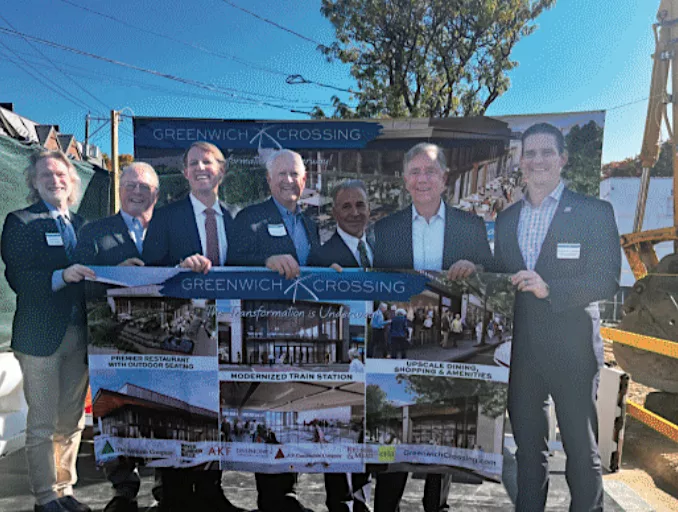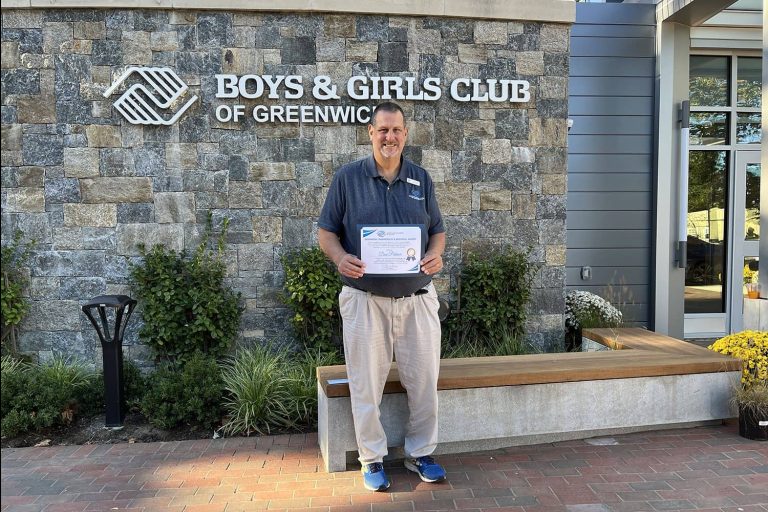The $30 million Greenwich Crossing project officially broke ground on Monday, signaling the beginning of a redevelopment of the area surrounding the Greenwich Train Station. The project, led by The Ashforth Company, will include a 5,000-square-foot premier restaurant, renovated retail spaces, and a redesigned train station.
Greenwich First Selectman Fred Camillo stood at the forefront of the groundbreaking ceremony for the $30 million Greenwich Crossing project. Camillo hailed the redevelopment as “the most transformational project to this point,” reflecting on the years of work that led to the day’s event.
Camillo, who has been deeply involved in the planning of this project, addressed the crowd of local officials, business leaders, and community members with visible enthusiasm. “This really is going to be transformational for this area,” he said. He emphasized the importance of this project for the town’s continued growth and vibrancy. “I can’t believe it’s been over five years since we started meeting on this,” he remarked, underscoring the long-term effort required to bring this project to fruition.
Governor Ned Lamont also praised the collaborative efforts that led to the project’s commencement. “There are a hundred ways to say no. There’s only one or two ways to get to yes. Thank goodness we got to yes,” Lamont said. And I love what this means in terms of Greenwich, my hometown, and our vibrant downtown. As Freddy knows, I love seeing Greenwich Avenue come to life. I love to see the outdoor dining. I love to envision what Greenwich Crossing is going to be right here. I’d love to thank Freddy.”
“You and I are going to have that glass of wine – come join us sitting outside,” Lamont joked, alluding to Camillo’s earlier comment about how he hoped to see everyone gathered together in the future to celebrate the project’s success with a glass of wine in hand.
The project is expected to modernize the downtown area by creating a more seamless connection between Greenwich Avenue and the train station, enhancing both the aesthetic and functional aspects of the space. Camillo praised The Ashforth Company for its commitment to the project, stating, “I want to thank Ryan and Daryl and the Ashforth family for bringing this forward.”
Ryan Harvey, CEO and President of The Ashforth Company, kicked off the event by highlighting the importance of the project. “We’re proud to commence the construction of Greenwich Crossing,” Harvey said. He emphasized the project’s potential to reshape the downtown area.
Harvey noted the historical connection the Ashforth family has with the site, explaining that under the leadership Henry Ashforth Jr., the family purchased the property in 1961. “We have been tied to this spot ever since,” he said, describing the project as part of a long-term partnership between the Ashforth Company, the Town of Greenwich, the State of Connecticut, and the railroad.

Frank Prial, Principal at Beyer Blinder Belle Architects & Planners, the firm responsible for the design of Greenwich Crossing, spoke about the project’s architectural goals. “Our goal was to learn the lessons that we had from great previous projects,” Prial said, referencing the restoration of the Grand Central Terminal. “We wanted to create a place that continued the shopping experience, made the passageways and pathways more interesting, more efficient, and to also encourage a place that people would want to stay, to enjoy, and to engage.”
Benjamin Limmer, Bureau Chief of Public Transportation at the Connecticut Department of Transportation, focused on the transit-oriented development (TOD) aspect of the project. “TOD is a major focus for us here at the DOT, and we believe this project is going to absolutely transform the public transportation experience for all riders across our state,” Limmer said. He emphasized the importance of public-private partnerships, saying, “Greenwich Crossing is another example of what can be done when public and private partners collaborate to make stuff happen.”
The project will continue over the next year, with the renovation of the train station set to begin in May 2025. Local officials, including Camillo, expressed excitement about how Greenwich Crossing will integrate with the town’s existing infrastructure, connecting the train station seamlessly with Greenwich Avenue and enriching the area with new experiences for both residents and visitors.
As the event concluded, Harvey thanked the town and state officials, as well as the many consultants and experts involved, for their support. The morning’s speeches highlighted the importance of collaboration, community engagement, and thoughtful planning in making Greenwich Crossing a reality.
This project is poised to reshape the landscape of downtown Greenwich, further solidifying the town’s reputation as a desirable destination for both commerce and community life.
Aside from Citibank and Signature Cycle, which will remain in their existing locations, the anchor restaurant and other storefronts are available for lease.







